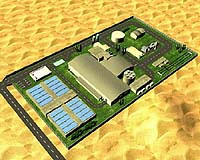The idea of using nuclear-powered desalination plants is becoming popular in the Middle East and North Africa, where tension over water rights has gone on for millennia, but it is controversial, and without significant foreign assistance it may turn out to be a mirage.
During a visit to Libya by French President Nicolas Sarkozy in late July, the leaders signed a memorandum of understanding that would allow French nuclear-giant Areva to build a nuclear power plant there.
Libya hopes to use the electricity generated by nuclear power for water desalination, a hope echoed in many countries in the region. Egypt has said it will pursue a similar scheme, as have Saudi Arabia and the other Gulf Cooperation Council countries -- Bahrain, Qatar, Oman, Kuwait and the United Arab Emirates. Japan and Kazakhstan already have working nuclear-powered desalination plants.
The Middle East, like much of the rest of the world, is increasingly in need of fresh water. About 60 percent of the roughly 7,500 traditionally powered desalination plants can be found in the Middle East. In fact, Saudi Arabia holds about a quarter of the world's desalination capacity, according to the International Desalination Association, and it provides 70 percent of the country's drinking water.
Removing enough salt from seawater to make it usable for irrigation and drinking takes a tremendous amount of energy. It is highly dependent on the method of purification used, as well as the salinity of the water -- seawater takes much more energy than slightly brackish water -- but on average it takes between 2.8 and 9.8 megawatts of energy to produce 100,000 cubic meters of drinkable water per day, according to a presentation on nuclear desalination by Ron Faibish of the Argonne National Laboratory, the largest research laboratory of the U.S. Department of Energy.
Almost all desalination plants in use around the world today are powered by oil, natural gas or coal, which attracts criticism for their greenhouse gas emissions.
The World Wildlife Fund, in a June report, criticized desalination for the amount of carbon dioxide produced by these traditionally powered plants.
"Worldwide, the electrical power generating sector is the world's most significant single generator of carbon emissions, responsible for 37 percent of global emissions. Always operating large scale desalination plants are also generally unsuited for variable power sources and tend to add to the base load power requirements most likely to be generated by burning fossil fuels," the report found.
There are several technologies for desalinizing water, and thermal distillation, which is the most conventional and most common in Middle Eastern countries such as Saudi Arabia, is also responsible for producing the highest rate of greenhouse gases, according the WWF.
With these disadvantages in mind, governments and businesses have been looking for alternatives to hydrocarbon-powered desalination plants. Australia has been using energy from a wind farm near Perth to power a large desalination plant that provides 17 percent of the city's freshwater supply.
Solar power is also being considered, but the scale for such technologies is inadequate for much of North Africa and the Middle East. A project in Spain hopes to develop a plant with the capacity to produce 50 cubic meters per day. Saudi Arabia's current daily production is 3 million cubic meters.
Using nuclear power for desalination has some very powerful backers. Not only do private industry giants such as Japan's Mitsubishi Heavy Industries and Areva, which controls France's nuclear sector, hope to build in North Africa and the Middle East, but the International Atomic Energy Agency has thrown its weight behind the idea as well with its Nuclear Desalination Project, which facilitates nuclear desalination projects worldwide.
Nuclear power, however, is very expensive. A 1,000 megawatt reactor that Egypt has discussed building is estimated to cost about $1.5 billion, and that cost has been cited as an important reason why Egypt must look abroad for financing. The Areva reactor that may be built in Libya is thought to be about the same size.

